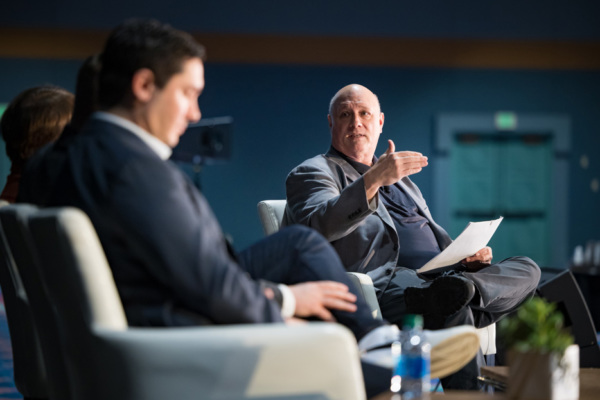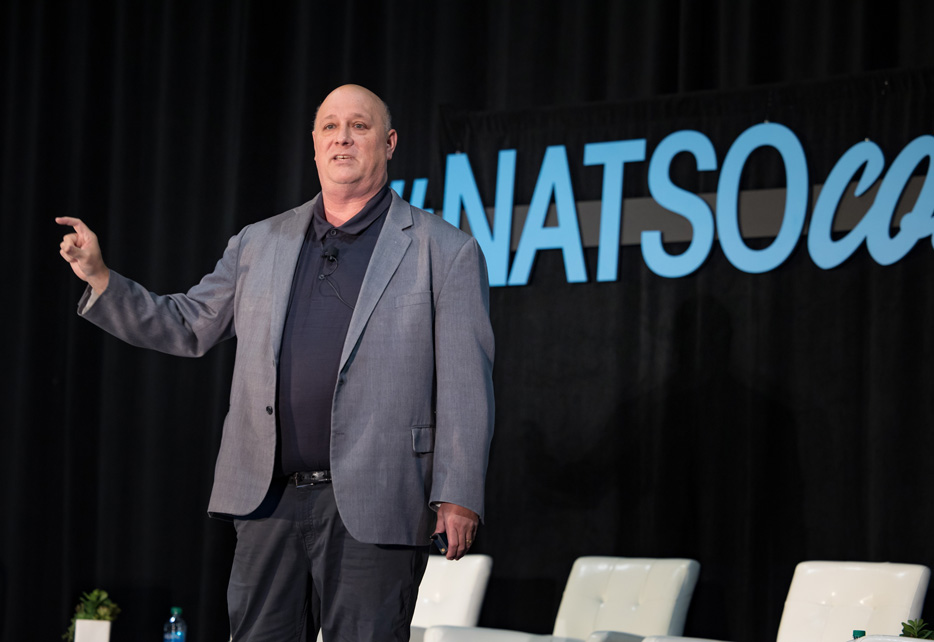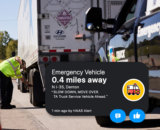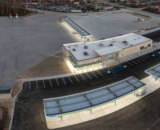Customers increasingly want speed and convenience, and the use of kiosk ordering and self-check-out lanes has become a must-have for retailers. Customers expect to order and checkout easily and quickly, and retailers are investing in technology to help customers get in, get out and get on their way even faster. Plus, technology enables locations to reassign their labor and improve order accuracy.
“Consumers are expecting more contactless options that include self-checkout, contactless payment, kiosks, and the ability to order and checkout on their phone devices,” said Greg Buzek, president of IHL Group. “We are seeing 178 percent increase in self-checkout installs in the next two years in our surveys, and the retailers growing the fastest are allowing consumers to check out on their own phones at 81 percent higher rates.” (Buzek, pictured above, presenting at NATSO Connect 2022.)
Consumer mobile checkout installs are projected to grow 300 percent, and contactless payment installs are slated to grow 190 percent in the next two years, Buzek said.
Even before the pandemic, Forrester reported that 32 percent of shoppers would change locations or abandon their trip entirely in response to long lines, said Toby Awalt, director of product marketing for Mashgin. Plus, a study from Shekel reported that 87 percent of customers prefer contactless or touchless options. (Mashgin, pictured above, held a booth at NATSO Connect 2022.)
“Improving checkout speed shortens lines and directly results in more sales. Given that the pandemic makes customers even more weary of lines, and the labor shortage has increased the time it normally takes to checkout, we can only predict the effect is even more pronounced today,” Awalt said.
Darren Schulte, NATSO’s vice president of membership, said today's consumers are also looking for the ability to scan and go quickly. “Our industry is built on speed, and speed is a critical piece of operators’ success,” he said, adding that customers want to use their phones to walk into stores and buy things. “A couple of years ago, we were talking about the magic of the Amazon store where you could pick up your items and walk out. That is already upon us.”
Consumer comfort with and expectations of self-checkout technologies are at an all-time high, Awalt said. “With that influx of utilization, it's going to be important that self-checkout-options and frictionless technologies alike work closely with other expected customer systems like loyalty programs,” he said.
Mashgin’s kiosks use computer vision to instantly ring up multiple items, speeding up transactions as much as 400 percent. “We combine multiple cameras with artificial intelligence to understand objects from multiple angles and produce a 3D profile of the object. That extra bit allows us to increase accuracy to 99.9 percent and easily differentiate between different sizes of the same item,” Awalt said. “This technology is so robust it works on plates of food that may come out of a kitchen differently each time.”
Consumers want to visit locations where they know they have a known transaction time or that are a destination location, Buzek said.
Spurring Purchases
Michael Suswal, co-founder and chief business officer, Standard AI, said users of Standard AI’s system, which uses AI for autonomous checkout, have larger basket sizes and shorter wait times in the store. “We have 25 percent of shoppers in and out under a minute, and baskets are bigger,” he said. (Suswal, pictured above, presenting at NATSO Connect 2022.)
Chase Thomason, CEO, Skip, said retailers using Skip’s scan-and-go solution typically see a 4.5 percent item increase and a 6.5% spending increase. “For our kiosk, we’re typically seeing around a 55–60 percent basket spend increase,” he said. (Skip, pictured above, shared their equipment at NATSO Connect 2022.)
At locations featuring Mashgin’s AI technology, 30 percent of sales go through the checkout. “When you hit that point, the technology pays for itself, and the cashiers have better lives,” said Jack Hogan, vice president of partnerships, Mashgin.
Meeting Labor Challenges
POS technology not only speeds customers through but also can help with labor challenges, which are creating challenges for nearly every industry. Point-of-sale technology can be used to redeploy labor. Self-checkout technology can build in flexibility for the staff or eliminate labor, allowing employees to focus on other areas of the business. “By reducing the amount of time employees have to spend on checkout, we give them back time for all of the key operational tasks they take on to keep the store running,” Awalt said.
IHL estimates that nearly 4 million jobs in stores and restaurants evaporated due to the pandemic changes, Buzek said. “We expect maybe only 10–15 percent of those workers will be coming back once COVID is over. So, the implications are significant,” he said.
Truckstop and travel plaza operators must decide the optimum use for their workers. “Is it staffing a POS unit for checkout, or do you deploy self-checkout with one employee overseeing four to six units? Do you use kiosks to eliminate the front line in a fast-food restaurant? Speeding the checkout is key, lowering the amount of employee involvement is crucial,” Buzek said.
Locations also have to have the ability to sell age-restricted merchandise or items such as lottery tickets via self-service, Buzek said. Having dedicated lines for age-restricted items or lottery can help speed lines.
Determining the ROI
When considering POS investments, retailers should consider the number of customers daily and during their busiest hours, the time to implement new technology and the return on investment, Awalt said. He explained that there are two main avenues for determining the ROI on new POS technology— transactions per staff member and increased retail and gas sales from improved throughput. With transactions per staff member, retailers can look at how many transactions occur daily versus the time they occur and the number needed to service transactions.
“This shows improved efficiency and profitability,” Awalt said, adding that retail and gas sales can increase if customers move through locations faster. “As lines shrink, retail sales increase, and people get back to their vehicles faster, opening up pumps to service new customers faster.”
As a bonus, locations could improve employee retention. “This one we're still investigating and is more exclusive to self-checkout or frictionless technologies. The working theory is that by reducing stress on staff, they should churn at a lower rate, saving your team recruiting and training costs,” Awalt said.
Preparing for the Future
Operators have to evaluate the latest POS technology for long-term success. “It is no longer as simple as having a register. We have to be thinking about the future,” Schulte said. “If you’re not innovating, you’re dying.”
Sophisticated c-store operators entering the truckstop and travel plaza space are exceptional at moving people through the store, Schulte said. “If you’re not looking at ways for the POS to make the purchase process faster, more frictionless and easier, you’ll find yourself more antiquated in the next three to five years,” he explained.
However, there isn’t a one-size-fits-all approach, and operators must factor in their unique customer base and needs. “Each company and location is different, and the best technology for one is not the best for others,” Buzek said.
During a NATSO Connect 2022 keynote address “Checkout Technology: How Your Customers Want to Checkout Has Changed,” Greg Buzek, IHL Group, moderated a panel discussion with Jack Hogan, vice president of partnerships, Mashgin; Darren Schulte, vice president of membership, NATSO; Michael Suswal, co-founder and chief business officer, Standard AI; and Chase Thomason, CEO, Skip.
Subscribe to Updates
NATSO provides a breadth of information created to strengthen travel plazas’ ability to meet the needs of the travelling public in an age of disruption. This includes knowledge filled blog posts, articles and publications. If you would like to receive a digest of blog post and articles directly in your inbox, please provide your name, email and the frequency of the updates you want to receive the email digest.






